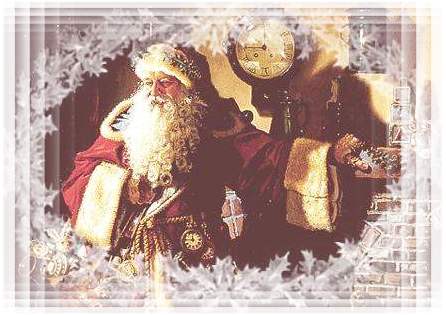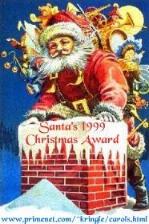


Once the Dutch brought Saint
Nicholas to America, he
was gradually transformed from an austere bishop to a
jolly old elf. First Washington Irving described the
saint as a plump and jolly old Dutchman in his comic
History of New York. It provided the first literary
description of Saint Nicholas to appear in America. It
poked fun at the Dutch founders of New York and
contained numerous references to the Dutch patron
saint. In later editions of his work, Irving gave this
account of Saint Nicholas bringing gifts:
“and lo, the good St. Nicholas came riding over the tops of the
trees, in that self-same wagon wherein he brings his yearly
presents to children....And he lit his pipe by the fire and sat
himself down and smoked....And when St. Nicholas had
smoked his pipe, he twisted it in his hatband, and laying his
finger beside his nose, gave the astonished VanKortlandt a
very significant look; then mounting his wagon, he returned
over the treetops and disappeared.”
Irving's book was a best seller of the day and after its
publication in 1809, the Saint Nicholas legend traveled
fast. At the first anniversary for it, John Pintard and his
friends at the New York Historical Society passed out a
broadside he'd commissioned with his own money. It
included a poem, "Sancte Claus Goed Heyligman!"
("Santa Claus, Good Holy Man!"). It was a wood
engraving by Alexander Anderson and the first known
picture of the saint to be made in America.

In 1822 Saint Nicholas' American transformation was
given a more definitive description by a professor
named Doctor Clement Clarke Moore. Moore, the
father of several children, presented his family with a
Christmas first: the famous poem, A Visit From Saint
Nicholas, first published in 1823. The poem quickly
became popular around the United States. Unlike the
European Saint Nicholas who was feared by naughty
children, Clement Moore inadvertently Americanized
the Old World Saint Nicholas, turning him into "jolly
Saint Nick, a plump, happy-go-lucky elf with a sleigh
full of toys and eight flying reindeer.

Through the years, many publishers have offered
Moore's poem as an illustrated book for children. The
first one was published in 1848 by Henry M.
Onderdonk, a New York printer and bookseller, and a
friend of Clement Moore. C. Boyd did eight wood
engravings depicting sleeping children, stockings
hanging, the Christmas elf driving his miniature team
through streets and over rooftops of a quaint
old-fashioned Dutch New York, and other familiar
scenes to every illustrated edition since. These were
put together in an eight-page pamphlet prepared as "a
present for good little boys and girls." Only two know
copies of that paperback publication have survived.

In 1860 Thomas Nast immortalized Santa Claus with
an illustration for Harper's Weekly. The Gregory
Company of New York contacted him with an offer to
do the illustrations for a book of Christmas poems,
including Clement Moore's. Acquiring a copy, Nast
read it repeatedly, making mental sketches of the
character. He wanted a warm, jolly old elf. The first
Santa Claus appeared as a small part of a large
illustration titled "A Christmas Furlough" in the
December 26, 1863 issue and each Christmas following,
Nast set aside his regular news and political coverage
to a Santa Claus drawing. He provided twenty -three
years of Santa Claus until the paper changed from a
leading newsweekly into a magazine for late
nineteenth-century homemakers.

Saint Nicholas' attire has gone through as many
changes as he has. In New York City in 1865, at
midnight on Christmas night, it was reported that Saint
Nick appeared, at ball given in his honor, in "buckskin
boots of large proportions; his pants were of a fawn color, with
a blue stripe. A vest of scarlet, with large brass buttons,
encircled a truly aldermanic paunch. A coat of dark brown,
over which was thrown an ample cloak of scarlet and gold
completed his attire. He was laden with toys - they hung
from his arms, round his neck, his waist, and his back was
heavily freighted. Round the room he tripped good
humoredly, chuckling to himself as he distributed his stock
and trade to all." The figure seemed to have been elicited
from Robert Walter Weir's painting and drawing at
the Military Academy of West Point.

Clement Moore had clad in him in fur, common dress
for 18th century gentlemen. In 1884, when Santa made
his entrance at the Five Points Mission School, eight
hundred wide eyed children saw him "wrapped in a
great coat of Siberian wolf skins, over which his long
beard hung down to his knees!"
But Santa Claus was often
shown dressed in green
clothes, or blue or black. When one Clement Moore's
daughters did a calligraphy of version of her father's
famous poem as a Christmas gift to her husband,
in spite of her father's words, she dressed Saint Nicholas
in a long green coat.

Back to the Top
|
|

It was the 1870 edition of "A Visit From Saint Nicholas"
that Saint Nicholas wore a red cloth coat. Thomas Nast
has depicted him in a reddish brown outfit, trimmed in
white ermine, in 1866. This illustration appeared in
George P. Walker's verse story "Santa Claus And His
Works" and was probably a major contributor to the idea
that Santa wore red and that he lives in the North Pole.
In the early twentieth century, red Santa Claus suits
became popular and were sold by department stores
and through mail-order by Sears and Roebuck.
By the mid-nineteenth century, stores called themselves
"Santa Claus Headquarters" at Christmastime.
The Boston Store in Brockton, Massachusetts, became the
father of department store Santas when it hired a
Scottish immigrant who was tall, roly-poly, had a white beard,
a cheerful voice and a hearty laugh, to be Santa Claus.
Before the turn of the century, department stores across
America had added Santa Claus and even
sat him on a throne. Children sat on his knee and
whispered their secrets into his ears.
And beginning in the latter part of the eighteen hundreds,
children wrote letters to Santa Claus. By the end of the century,
post offices had overflowed with letters to Santa every year!
Write
to Santa Claus



Back
to the Top
Christmas
:: Going Home :: Christmas Stories
Giving Gifts :: Santa Claus :: Decorating I
Decorating II :: Traditions I :: Traditions II
Birth of Christ

Updated:
January 07, 2006
©GrannyDancer Productions, 1999-06
all rights reserved
Home || Spring || Summer || Autumn || Winter
St. Patrick's Day || April Fool's Day || Easter || Mother's Day
Memorial Day || Father's Day || Independence Day || Friendship Day
Labor Day || Back to School || Grandparent's Day || Columbus Day
Halloween || Election & Return Day ||
Veteran's Day
|| Thanksgiving
Christmas || Hanukkah || Nutcracker Ballet || Secret Santa 2002
New Year's Day || Martin Luther King, Jr ||
Kwanzaa
Groundhog Day || Valentine's Day || President's Day || Mardi Gras
Arbor Day || Happy Birthday || Webrings || Awards || Flag Day
January || February || March || April || [May || June || July
August || September || October || November || December
No Right Click
by Renigade
Underline Remover
|